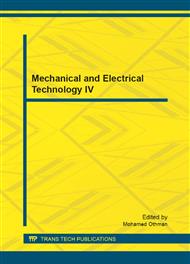[1]
MM. Ali moon KS Structural Developments in Tall Buildings: Current Trends and Future Prospects [J]. Architectural Science Review,Vol. 50 ( 3) (2007), pp.205-223.
DOI: 10.3763/asre.2007.5027
Google Scholar
[2]
He W, He R. Recognition of progress based on the dynamic properties of structural damage. North China Institute of Water Resources and Hydropower, Civil and traffic institute, Zhengzhou, Vol. 2 (2012), pp.28-31.
Google Scholar
[3]
Gang CH. Experimental study on structural damage detection based on modal parameters. Kunming University of Science and Technology , (2007).
Google Scholar
[4]
Jianrong H Diagnostic studies based on modal analysis of structural damage. Southwest Jiaotong University (2006).
Google Scholar
[5]
Li X. Frame structure damage detection of joint strain modal approach . Journal of Guangzhou University, Vol. 4 ( 5) (2005), pp.423-427.
Google Scholar
[6]
Pengying G, Houqun CH. Direct indicator method based on the damage strain modal structural damage identification. Progress in Natural Science, Vol. 17 ( 2) (2007), pp.240-247.
Google Scholar
[7]
Salawu, O.S. Detection of structural damage through changes in frequency: a review . Eng. Struct, Vol. 19 (9) (1997), p.718–723.
DOI: 10.1016/s0141-0296(96)00149-6
Google Scholar
[8]
Jun X, Dajian H. An improved structural damage identification method based on frequency measurement. Engineering Mechanics, Vol. 21(1) (2004), pp.21-25.
Google Scholar
[9]
Jinyu X, Qiding ZH. Damage identification method based on modal analysis of steel. Northwestern Polytechnical University, College of Mechanics and Civil Engineering and Architecture Vol. 26 ( 2) (2007), pp.206-208.
Google Scholar
[10]
Jianrong H. Diagnostic studis based on modal analysis of structural damage. Southwest Jiaotong University, (2006).
Google Scholar
[11]
Ji Y. Engineering structural damage identification based on modal analysis. Anhui Agricultural University (2007).
Google Scholar
[12]
Worden K, Manson G, Allman D. Experimental validation of a structural health monitoring methodology: part I. novelty detection on a laboratory structure. Journal of Sound and Vibration, 2003, 259(2): 323-343.
DOI: 10.1006/jsvi.2002.5168
Google Scholar
[13]
Pengying G. Direct indicator of the strain modal - based structural damage diagnosis method. Hohai University (2006).
Google Scholar
[14]
Wei Fan,Pizhong Qiao . A strain energy-based damage severity correction factor method for damage identification in plate-type structures. Washington State University, USA. Shanghai Jiao Tong University, China. Vol. 28 (2012), p.660–678.
DOI: 10.1016/j.ymssp.2011.11.010
Google Scholar
[15]
Duan Z D,Yan G R, Ou J P, et al. Damage detection in ambient vibration using proportional flexibility matrix with incomplete measured DOFS . Structural Control and Health Monitoring, Vol. 14 (2) (2007), pp.186-196.
DOI: 10.1002/stc.149
Google Scholar
[16]
Qiuwei Y, Jike L. Research progress of the project structural damage identification method of the flexibility. 1. Shaoxing College of Arts and Sciences Department of Civil Engineering 2. Zhongshan University applied mechanics and engineering, Vol. 30 (12) (2011).
Google Scholar
[17]
Bernal D. Load vectors for damage localization . Journal of Engineering Mechanics , Vol. 128 ( 1) (2002), pp.7-14.
Google Scholar
[18]
Spencer B F Jr, Nagayama T. Smart sensor technology : a new paradigm for structural health monitoring [C]. Proceeding of Asia-Pacific Workshop on Structural Health Monitoring, Yokohama, Japan (2006).
Google Scholar
[19]
Bernal D. Flexibility-based damage localization from stochastic realization results. Journal of Engineering Mechanics, Vol. 132 ( 6) (2006), pp.651-658.
DOI: 10.1061/(asce)0733-9399(2006)132:6(651)
Google Scholar
[20]
Gao Y, Spencer B F, Bernal D. Experimental verification of the flexibility-based damage locating vector method. Journal of Engineering Mechanics, Vol. 133 ( 10) (2007), pp.1043-1049.
DOI: 10.1061/(asce)0733-9399(2007)133:10(1043)
Google Scholar
[21]
Bayissa W L, Haritos N, Thelandersson S. Vibration-based structural damage identification using wavelet transform . Mechanical Systems and Signal Processing, Vol. 22 (5) (2008), pp.1194-1215.
DOI: 10.1016/j.ymssp.2007.11.001
Google Scholar
[22]
Huai CH, Jingbing L, Xuegang Y. A new structural damage identification test methods. Zhengzhou University, Institute of Civil Engineering, Vol. 26 (01) (2011), pp.96-102.
Google Scholar


